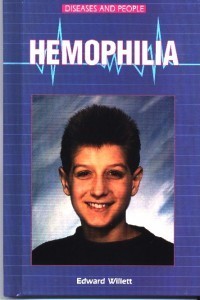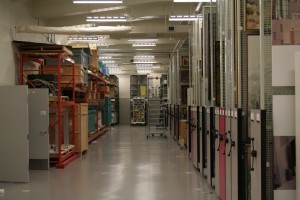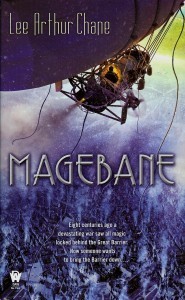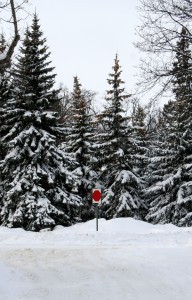Edward Willett's Blog, page 58
December 13, 2011
The Holy Grail of hemophilia treatment
 Over more than two decades of science writing, I've seen a lot of my past writings rendered obsolete by scientific progress.
Over more than two decades of science writing, I've seen a lot of my past writings rendered obsolete by scientific progress.
Case in point: the release last week of a research report on exciting new progress in gene therapy for hemophiliacs.
Back in 2001, I wrote a book on hemophilia for the Enslow Publishers series Diseases and People (School Library Journal called it: "An excellent resource for basic research for personal or academic use.").
Gene therapy—the insertion of genes into living cells in the human body to treat disorders—has always seemed to hold particular promise for the treatment of hemophilia because it is a genetic disease: you can't catch it, you can only inherit it.
What is hemophilia? Allow me to quote my own book:
"Hemophilia is a disease in which a person's blood does not clot properly. People with hemophilia do not produce enough of one of several proteins in the blood called clotting factors. The body needs these factors to stop bleeding after an injury. Without these factors, bleeding lasts longer than it would otherwise…
"Hemophilia affects males almost exclusively. About one in 5,000 boy babies has hemophilia. It is passed on from generation to generation by women who may or may not show bleeding-related symptoms themselves. In about one third of the cases, there is no family history of hemophilia…
"The primary symptoms of hemophilia are abnormal bruising and bleeding. In toddlers, falls and bumps may cause skin bruises and bleeding from the lips and tongue. In older children and adults, bleeding may involve muscles and joints, producing painful swelling and hindering movement. If early treatment is not given, this bleeding can result in permanent joint damage. Head injuries are particularly dangerous for hemophiliacs…bleeding into the brain can be fatal. Bleeding may also occur in the face, neck, or throat, obstructing breathing. Bleeding from the mouth, gums, and the nose may be troublesome, as well…
"The standard treatment in the event of bleeding is to inject the hemophiliac with the missing blood clotting factor, made from either donated plasma or by using recombinant gene technology. This can be done on a regular preventative basis, usually three times a week, just before undertaking an activity that could cause bleeding, or as needed to treat episodes of bleeding…
Hemophilia is, in short, a nasty condition indeed. Prior to the First World War, the average lifespan for a boy with hemophilia was 11. Prior to 1968, it was only 20. By 1983 it was 64…but during the 1980s it dropped again due to the impact of AIDS, which hemophiliacs contracted through the injection of blood clotting factor made from donated, infected plasma (young Ryan White, who graces the cover of my book, was one of the most high-profile victims).
Since 1999, the average lifespan has been normal, but treatment still involves regular injections of clotting factors.
The only way to cure hemophilia would be to replace the missing genes that code for the production of clotting factors…and that's precisely what researchers from the University College London Cancer Institute and the St. Jude Children's Research Hospital in Memphis have just reported success with.
Their technique used a modified adeno-associated virus, or AAV (which infects human cells but doesn't cause disease) to insert the gene which produces clotting factor IX (FIX), into liver cells. Their test subjects were six people with severe Hemophilia B. (About one in five people with hemophilia have Hemophilia B; the more common Hemophilia A, which involves a different clotting factor, offers a more complex target for gene therapy, so much of the research has focused on Hemophilia B.)
Before the therapy, the six patients all produced FIX at less than one percent of normal levels. After the therapy, each produced FIX at between two and 11 percent of normal. In the short-term follow-up of six to 16 months, four of the participants no longer needed infusions of FIX at all, while the other two required them less frequently than before.
Molecular Therapy magazine, reporting on preliminary results of the study back in March, enthused that it represented nothing less than the "holy grail" of hemophilia gene therapy.
It also renders my 10-year-old book out-of-date. But you know what? After researching all the tragedy and suffering hemophilia has caused down through the years, I'm okay with that.
I just hope all the other books I wrote, on Alzheimer's disease, arthritis, meningitis and Ebola, are also rendered obsolete—the sooner, the better.
December 10, 2011
Saturday Special From the Vaults: There's A Puppy in My Pocket
 A new regular feature: stuff from the vaults, presented each Saturday.
A new regular feature: stuff from the vaults, presented each Saturday.
At the Mackenzie Art Gallery, the "vaults" (that's a picture of them at the left) are where they keep the permanent collection, most of which is not on display at any given time. Here at edwardwillett.com, the vaults are the file folders on my computer, or the file folders in my filing cabinet, that have filled up with odds and ends and stuff over the years: bits of poetry, poems, unpublished short stories, unfinished novels, old newspaper columns, etc., etc. Some of it dates back thirty years…or more.
Every Saturday, I'm going to pull something out of the vaults and post it…just because.
And we start with…a poem.
As writer-in-residence I always warn poets who come to see me that I don't write poetry.
Now you'll know why.
###
There's A Puppy in My Pocket
There's a puppy in my pocket
And a kitten in my coat.
I'm not sure what's in my Stetson,
But it may well be a stoat.
My shoes are full of shellfish
And my socks are full of squid,
And the turtle in my top-hat
Is about to flip its lid.
My jewelry box has June bugs
And my dresser's full of things–
Not the shirts and shorts that I wear–
No, it's full of things with wings.
I wake up quite sore each morning
'Cause my mattress has a lump:
But it could be worse. At least that camel's
Only got one hump.
A hyena ate my hair brush
And a cheetah chewed my chair,
And a fate too horrid to relate
Befell my underwear.
I still love my little bedroom,
And I think that you would too.
But I sometimes really wish it didn't
Overlook the zoo.
December 9, 2011
A Christmas Magebane giveaway contest!
 I just received a fresh batch of Magebanes from the publisher, and in the spirit of the season have decided to give two of them away. If you'd like an autographed copy of Magebane mailed to your door, just leave a message below: no need to leave any contact information except an email address–if you win, I'll get your mailing address from you then.
I just received a fresh batch of Magebanes from the publisher, and in the spirit of the season have decided to give two of them away. If you'd like an autographed copy of Magebane mailed to your door, just leave a message below: no need to leave any contact information except an email address–if you win, I'll get your mailing address from you then.
Contest closes Sunday, December 11, at midnight CST.
Remember, you can read the prologue and first chapter (or listen to me read them) here–you know, if you're not sure you want to win a copy and need a taste to whet your appetite.
Let the contest begin!
VOYA likes Magebane
 Although Magebane is not a YA novel, it does have relatively young protaganists, and there's certainly no reason older teens wouldn't enjoy it…a fact with which VOYA concurs. VOYA (it stands for Voice of Youth Advocates) magazine is "the leading library journal dedicated to the needs of young adult librarians, the advocacy of young adults, and the promotion of young adult literature and reading," so it's gratifying that their reviewer Heidi Uphoff has this to say about Magebane (it's not an unadulterated rave, as you'll see, but I'll take it!):
Although Magebane is not a YA novel, it does have relatively young protaganists, and there's certainly no reason older teens wouldn't enjoy it…a fact with which VOYA concurs. VOYA (it stands for Voice of Youth Advocates) magazine is "the leading library journal dedicated to the needs of young adult librarians, the advocacy of young adults, and the promotion of young adult literature and reading," so it's gratifying that their reviewer Heidi Uphoff has this to say about Magebane (it's not an unadulterated rave, as you'll see, but I'll take it!):
Chane created a fascinating and unique world in Magebane, a stand-alone fantasy novel. There is a little predictability with the main characters' story lines. Neither the romance between the sheltered girl and the worldly boy nor the prince who wishes for a more meaningful life are unexpected. Readers are likely to overlook this, however, as they race to find out what happens next in this fast-paced, action-packed book. This is an excellent recommendation for fantasy-loving teens looking for something out of the ordinary.
December 8, 2011
Snow business
 It's hard to believe that, in 20-plus years of science column writing, I have (as far as I can tell) only ever written about snow once. After all, snow is as much a fact of life in Saskatchewan as sun, wind, and the Riders losing.
It's hard to believe that, in 20-plus years of science column writing, I have (as far as I can tell) only ever written about snow once. After all, snow is as much a fact of life in Saskatchewan as sun, wind, and the Riders losing.
Perhaps there is a psychological reason for my avoidance of the topic of snow (and Rider losses), or perhaps it's simply that it's not very often there's anything new to say about what we euphemistically call "the white stuff."
But now there is! A scientist in California, of all places, has a lead on one of the great puzzles of snowflake science.
It's not, as you might think, "why no two snowflakes are alike": that's been understood, at least in broad strokes, for decades. In fact, that was the topic of my original snow column twenty years ago. To recap:
A snow crystal typically forms when water freezes onto a particle of dust (or, if it's below -40, just because it's below -40, at which temperature you'd freeze, too). The crystal grows as it falls, collecting more water vapor on the way. Crystals are six-sided because of the way water molecules bind together when water freezes, but that's the only thing that's consistent from crystal to crystal.
Scientists have distinguished seven basic shapes: plates, stellars, columns, needles, spatial dendrites, capped columns and irregular crystals. The shape is determined by the temperature and humidity at which the crystal forms. Platelike crystals form above -3 C and between -8 and -25 C. Columns form between -3 and -8 and below -25. Very moist air at around -7 forms needles. Lower the moisture slightly and those needles become short, fat columns.
Of course, snow crystals are seldom a pure example of any of these shapes. Columns may sprout plates on their ends, which in turn develop branches or needles. Each crystal is literally a record of all the atmospheric changes it experienced on its journey from the cloud to the earth.
In order to be identical two snow crystals would have to pass through exactly the same atmospheric conditions in exactly the same order for exactly the same amount of time, all the way down. One estimate is that each snow crystal might pass through a million different combinations of temperature and humidity, giving a possible one-with-five-million-zeroes-after-it possible sequences a crystal could pass through, each sequence altering its appearance.
Since the total number of snow crystals that have fallen in Earth's entire history is estimated to be a one with a mere 35 zeros after it, the odds are no two of them have ever been even visually identical.
Physics professor Kenneth Libbrecht at the California Institute of Technology became interested in snow in the 1990s (before that, he'd been focused on the sun and cosmic gravitational waves). What piqued his interest was a photo of a capped column, two flat flakes joined in the middle by a hexagonal column, making it look rather like a thread bobbin.
Libbrecht grew up in North Dakota, but he'd never seen such a thing. He went back to North Dakota, and discovered it was just because he'd never looked. Intrigued, he began photographing snow crystals, and has since published seven books and built up a library of more than 10,000 photographs…and developed methods for growing and analyzing snowflakes in a lab.
Recently Libbrecht has been focusing on the thinnest, largest plate-like snowflakes, which form at around -15 in high humidity. Some are as sharp as a razor blade. What he discovered is that the sharpening effect is the result of a growth instability.
When the crystal starts to form, the top edge develops a little bump, or ledge, whose corner sticks out a bit further toward the moist air and thus grows faster than the rest of the crystal. That sets up a cycle: the corner gets sharper, and thus grows faster still, and thus gets sharper, and thus grows still faster…and pretty soon you have a flat, sharp-edged flake.
If this sharpening effect turns out to occur at other temperatures—and it likely will—then it could explain how tiny, tiny changes in temperature during the snowflakes' fall produce such wildly varying structures, how, as Libbrecht puts it: "the ice growth rates can change by a factor of 1000 when the temperature changes by just a few degrees."
Or, at least, it begins to explain it. More research (as always) is needed. But still, it's a real advance in snowflake science.
Not, alas, the advance I'm looking for, which is self-shovelling snowflakes. But, hey, it's a start.
(The photo: A stop sign in the snow near the Saskatchewan Legislative Building.)
December 4, 2011
A couple of more Magebane reviews…
 First up, Just a Guy Who Reads Books begins his review by saying:
First up, Just a Guy Who Reads Books begins his review by saying:
Chane combines some steampunk sensibilities with a magic world, infuses the whole thing with some potent political plotting, and presents the result – a fantastic novel.
And finishes…
Ultimately, a highly satisfying novel. I'd love to see something further in the world that Chane has created…
Review Room has some quibbles, but still says:
I found the book quite appealing because it pitted science against magic, and couldn't help being drawn in by the detailed descriptions of this alternate magical reality – it's spells, it's inventions and it's different life. Commoners have achieved through science which the MageLords do via Magic. Against this backdrop Chane has created well-fleshed out characters. He gives the reader a look-see into their minds, which was quite interesting. The story has many twists and turns and is quite unpredictable so it keeps one engaged and reading.
Interestingly, both reviewers (and some previous ones) note they'd be interested in seeing more of the world of Magebane. So would I! Which is why I have proposed a sequel. Still waiting for word on it from DAW, though, so…cross your fingers for me!
November 29, 2011
Creative cheaters
 I like to think I'm a fairly creative guy. It's hard to write a bunch of science fiction and fantasy novels without having at least a modicum of creativity.
I like to think I'm a fairly creative guy. It's hard to write a bunch of science fiction and fantasy novels without having at least a modicum of creativity.
I also like to think I'm an honest guy. Tell the truth, keep your word, don't cheat: that's how I was brought up, and I do my best to live up to my upbringing.
According to a new study, though, that may make me a mite unusual. Research just published by the American Psychological Association (APA) indicates that creative people are more likely to cheat than less creative people.
The research, conducted by Francesca Gino of Harvard University and Dan Ariely of Duke University, appeared online in the APA's Journal of Personality and Social Psychology under the title, "The Dark Side of Creativity: Original Thinkers Can Be More Dishonest."
Gino and Ariely first used a series of established psychological tests to measure their subjects' creativity, and also tested their subjects' intelligence. Then they carried out a series of five experiments.
In each, the participants received a small sum of money just for showing up. Then they were presented with various tasks and tests, each of which was designed so that they could be paid more if they cheated.
For example: they took a general knowledge quiz, circling their answers on the test paper (and were told they would be paid more for correct answers) Afterward the experimenter told them to transfer their answers to "bubble sheets", but also told them that she had photocopied the wrong sheet and that as a result the correct answers were already lightly marked on the sheets.
So: the participants had incentive to cheat (more money for correct answers) and the impression they could cheat without detection when transferring their answers (in reality, all of the papers had unique identifiers so the experimenter would be able to tell if they'd cheated).
The results? Those whose tests indicated they were the most creative were also significantly more likely to cheat. (On the other hand, there was no link between intelligence and dishonesty, so those who were more intelligent but less creative were no more likely to cheat than those who lacked both intelligence and creativity.)
In another experiment, the subjects were shown drawings with dots on both sides of a diagonal line, and were asked to indicate whether there were more dots on the left or the right side. In half of the 200 trials, it was virtually impossible to tell: but participants had been told they'd be paid 10 times as much (five cents, rather than half a cent) each time they said there were more dots on the right side…and, sure enough, creative participants were significantly more likely to give the answer that paid more.
So why should creative people be more likely to cheat? The researchers believe it's because creativity makes it easier for people to rationalize their actions. Or as Francesca Gino put it in the APA's press release summing up the results, "Greater creativity helps individuals solve difficult tasks across many domains, but creative sparks may lead individuals to take unethical routes when searching for solutions to problems and tasks."
In the paper itself, the researchers concluded that "the results from the current article indicate that, in fact, people who are creative or work in environments that promote critical thinking may be the most at risk when they face ethical dilemmas."
Now, as I should probably point out more often than I do, it's dangerous to draw too many conclusions from a single study. The authors themselves note that the most obvious limitation to their work is the fact that they created situations in which people were tempted by money to cheat.
They suggest further researcher into whether creativity leads people to satisfy selfish, short-term goals rather than their higher aspirations when faced with what they call "self-control dilemmas"—such as eating a slice of cake when trying to lose weight.
In other words (my other words, not theirs), if you're creative enough, maybe you can justify anything—even things that ordinary, less-creative people would take one look at and say, "that's just plain wrong."
"Thinking outside the box" can lead to great discoveries and amazing advancements…but sometimes, thinking outside the box can land you in trouble.
Or potentially, if you're particularly creative, in jail: and all the thinking in the world won't get you out of that box.
(The photo: Nothing to do with anything, really, but it's kind of creative.)
November 24, 2011
The doorway to forgetfulness
 It's been a staple gag of TV sitcoms for years: an older character walks into a room and says, "Now, what did I come in here for?"
It's been a staple gag of TV sitcoms for years: an older character walks into a room and says, "Now, what did I come in here for?"
But gags like that are funny because they have a grain of truth in them, and increasingly, I'm finding that grain of truth sticking in my own aging gullet.
Of course, when an oyster finds an irritant in its gullet, it turns that oyster into a pearl. My equivalent is turning it into a science column. (Albeit obviously not one focusing on the biology of the oysters, since even if they have gullets, I'm pretty sure that's not where they make pearls.)
As it turns out, this science column is even more like a pearl than I thought. After all, pearls reduce an oyster's irritation. And I find myself far less irritated by my lapses of memory now that I've learned it may not have all that much to do with age. Rather, it appears the blame lies with doorways.
No, that's not a non sequitur and even further evidence of the decay of my mental processes. Research just published in the Quarterly Journal of Experimental Psychology really does indicate all of us, regardless of age, are more likely to forget things when we pass through a doorway.
The research, conducted by Gabriel Radvansky, a psychology professor at Notre Dame University, refines some of his previous research which already indicated that moving from room to room can make us forgetful.
In the new study, Radvansky conducted three experiments. In the first, participants used a virtual environment like you'd find in a computer game. They selected an object from a table in one virtual room–say, a blue wedge–and either walked across the room to another table, set down the object, and picked up a different object, or walked into another room (through a doorway), set down the object, and picked up a different object. Along the way, they were "probed" with the name of an object, asked if it was either the object they were carrying or the one they had put down (they couldn't see the object they were carrying or the one they had set down). Those who passed through doorways were more likely to have forgotten what they were either carrying or had just set down than those who had merely crossed the room.
In his previous experiments along these lines, the experience was made as immersive as possible, using a 66-inch diagonal screen the participants sat very close to. The new experiment used only 17-inch monitors, to see if what Radvansky calls the "location-updating effect" depends on how immersive the experience is. Apparently, it does not.
In the second experiment, Radvansky for the first time tested the effect in the real world, to see if it was just an artifact of a sensory-impoverished virtual world. To make sure participants couldn't see what they were carrying or had set down, the objects were concealed in black boxes. Sure enough, walking through a doorway increased forgetfulness.
In the third experiment, once more in the virtual environment, participants passed through several rooms but ended up in the same room they had started in, to see if the ability to remember is linked to the environment in which a decision is made. The experiment showed no improvements in memory upon returning to the original room.
All of this supports the "event horizon model of event cognition and memory" that Radvansky and his colleagues have been developing. The theory holds that our brains segment events into a series of "event models" that are processed one at a time. Passing through a doorway *an "event boundary") triggers the formation of a new event model: and information in the current event model takes precedence over the previous event model. When the brain needs to retrieve information for two event models at once, as when it is called upon to remember an object it incorporated into a previous event model but cannot now see, that "competitive retrieval" leads to "retrieval interference"–i.e., forgetfulness.
Frankly, I find not only reassuring, but inspiring. So inspiring, I think I'll write a sequel to Nancy Ford and Gretchen Cryer's off-Broadway musical I'm Getting My Act Together and Taking it on the Road.
I'll call it I Finally Got My Act Together But I Forgot Where I Left It.
(Sorry, no photo: I forgot.)
November 18, 2011
The Big Idea: Magebane
 (This is a slightly modified version of an essay that originally ran on John Scalzi's blog Whatever–here's the original version. John generously gives over his popular blog on a regular basis to authors with new work coming out, for which he deserves much praise and honor. Thanks, John!)
(This is a slightly modified version of an essay that originally ran on John Scalzi's blog Whatever–here's the original version. John generously gives over his popular blog on a regular basis to authors with new work coming out, for which he deserves much praise and honor. Thanks, John!)
I know this is called "The Big Idea," but my new fantasy novel Magebane didn't grow out of a single big idea. Instead, it grew out of four ideas: three big ones, and one not-so-big one. (But "The Big 3 1/2 Ideas" isn't nearly as catchy a name.)
First: it is, of course, one of the hoariest of fairy-tale tropes that an enchantment can be broken with a kiss: typically, a prince kissing a princess. But one day while I was musing on this (and since I have a young daughter, princesses are something I have mused about quite often), I had the notion of writing a story in which a kiss didn't just break an enchantment, it broke all enchantments: a story in which a kiss between a (sort-of) prince and a (kind-of) princess would bring magic itself crashing down in ruin.
Now, that's a somewhat subversive notion in fantasy fiction. Typically in fantasies the destruction of magic is not something devoutly to be wished: instead, they're all about the restoration of magic, or at least the triumph of good magic over bad magic. But magic is, ultimately, a form of power: and like all power, it can be abused. Particularly if some people have it, and others don't.
Second: since I was already thinking subversively in terms of making the overthrow of magic a good thing, I continued thinking subversively about another common fantasy trope, the idea that restoring the rightful king to a throne can solve all that has gone wrong in a kingdom.
In the real world, restoring absolute monarchs to power is generally not seen as a good thing. I mean, an absolute monarch is just a dictator with a jeweled hat, when you come right down to it. In the real world, we (well, most of us, at least) celebrate the overthrow of tyrants…even the ones that have been, perhaps, less tyrannical than some of their peers.
Where, I asked myself, are the democratic revolutionaries within fantasy fiction?
I decided to create some.
The third big idea: what happens in a world with magic when technology (any sufficiently advanced version of which, as Arthur C. Clarke famously said, is indistinguishable from magic) begins to give those who cannot wield magic the same abilities as those who can?
With these three ideas in hand, I fired up my story-making cauldron, tossed them in, stewed and steeped and stirred them for a while, and eventually poured off 150,000 words of what I'd like to think is pretty tasty story.
In Magebane, the tyrannical MageLords, who rule by virtue of their magical power (pretty much their only virtue), were thrown down from power centuries past in their old kingdom by the Commoners, the non-magical people they rule, with the help of something or someone called the Magebane. Fearing for their lives, the MageLords used magic to flee to the far side of the world, where they established a new kingdom, protected from attack by an impenetrable magical barrier.
But now there are various MageLords who would like, each for his or her own reasons, to remove that Barrier; there is a new Magebane; and there are, bubbling up from the increasingly technological advanced Commoners trapped in the kingdom with them, rumors of a new rebelliousness.
What no one in the kingdom realizes is that the Commoners outside, for whom the MageLords are nothing but myth, have explored the world right up to the Great Barrier itself…and that their technology has advanced far beyond that of the Commoners within the Barrier. That is, no one realizes it until one young man crash lands in the kingdom aboard the experimental airship that has just flown over the Barrier…
Yes, that's right: my big fat fantasy novel is also steampunky!
As for the small idea that is also part of the Magebane mix? That's the setting. The hidden kingdom of the MageLords is largely prairie in the south and forests in the north, with lots of lakes.
It has, in fact, the same geography as the Canadian province of Saskatchewan, where I live. And there's more: in the kingdom's capital, there is a white stone palace on the southern shore of a manmade man-made lake…just as there is in Saskatchewan's capital city of Regina, where the Saskatchewan Legislative Building rises on the south shore of Wascana Lake, just a couple of blocks from my house.
Alas, the real lake and the real park surrounding it are not magically protected from winter's ravages like the one in the book. You could call that wish-fulfillment, if you like, and I daresay you'd be correct.
But then, you could also call the whole book a kind of wish-fulfillment: a wish for fantasy that recognizes that even a benevolent dictator is still a dictator, and that whatever Tolkien may have primed us to believe, The Return of the King is not necessarily a happy ending.
Also, a wish for more fantasy with airships.
Because airships, like bow-ties on The Doctor, are cool.
November 17, 2011
The Space-Time Continuum: You got science in my fantasy!
 As I write this, I'm about to fly off to the World Fantasy Convention in San Diego, where I've been assigned to moderate a panel entitled "You've Got Science in My Fantasy!," featuring fellow writers Gregory Benford, Yves Meynard, Brent Weeks and L.E. Modesitt.
As I write this, I'm about to fly off to the World Fantasy Convention in San Diego, where I've been assigned to moderate a panel entitled "You've Got Science in My Fantasy!," featuring fellow writers Gregory Benford, Yves Meynard, Brent Weeks and L.E. Modesitt.
The panel is described this way: "In Operation Chaos, Poul Anderson's shapeshifters' abilities were limited by the law of conservation of mass. Do such considerations enhance the narrative?"
It's such an interesting question to me I thought that, with your indulgence, I'd use this column to work out my thoughts pre-panel.
You've undoubtedly heard the phrase "willing suspension of disbelief." It comes from Samuel Taylor Coleridge's 1817 book Biographia literaria or biographical sketches of my literary life and opinions. The full quote runs like this:
"In this idea originated the plan of the 'Lyrical Ballads'; in which it was agreed, that my endeavours should be directed to persons and characters supernatural, or at least romantic, yet so as to transfer from our inward nature a human interest and a semblance of truth sufficient to procure for these shadows of imagination that willing suspension of disbelief for the moment, which constitutes poetic faith."
The willing suspension of disbelief (although I kind of wish the term "poetic faith" had caught on instead) is essential for the enjoyment of any work of fiction or drama. We know we're watching an actor or reading a made-up story, but we pretend that what we are seeing is real or what we are reading really happened.
However, "willing suspension of disbelief" is easier in some cases than in others. A story set here and now in which nothing happens that could not happen in the world as we know it requires little suspension of disbelief. Fantasy stories, using, say, Coleridge's "persons or characters supernatural," or featuring powerful wizards, require a Golden Gate Bridge's level of suspension.
Some people find that they cannot suspend their disbelief that much, and so spurn on all tales of fantasy, horror or science fiction, muttering, "That could never happen."
Even those of us whose disbelief is usually suspended as easily as a soap bubble on spider silk can be thrown out of a story when something violates our own internal sense of what is and isn't believable.
A case in point for me: the giant floating island in Yann Martel's Life of Pi. I loved the book, but that one sequence caused my suspended soap bubble of disbelief to wobble severely. Up until then the book, for all its unlikely occurrences, seemed thoroughly rooted in the real world: at that point, because I knew such islands do not exist, I was plunged into a realm of fantasy, and since I did not think I was reading fantasy until I encountered that island, I was discombobulated.
The argument, then, in favour of getting "science into fantasy" is that a brief nod of the authorial head to scientific law, even when magic is involved, makes suspension of disbelief a little bit easier.
In my new fantasy novel Magebane (written as Lee Arthur Chane), for example, the energy for magic comes from heat: the MageLords in their palace actually have a giant coal furnace whose energy they draw on as required for major works of magic. (Smaller spells can draw energy from the air itself, which turns ice-cold as a result.)
To me, that little bit of grounding of the story in the laws of physics enhances the tale in two ways: it helps readers suspend disbelief, and it also places interesting restrictions on what the characters can do with magic–and just as grapes stressed by lack of water and high temperatures make the best wine, so do struggling characters make the best stories.
But when I posted some of these same thoughts online, one commentator said that when she reads of someone mixing science and fantasy, she figures the writer "could not grasp that something might exist, even in fiction, that didn't reduce to hard principles, something that tapped into poetry and imagery instead, something that could be implied instead of explicated," and feared it was a sign that "I am facing yet another book in which all the magic has been leached out of 'magic'."
Similarly, in a recent interview in New York Magazine, bestselling author George R.R. Martin said that, "When treating with magic in fantasy, you have to keep it magical. Many fantasy writers work out these detailed systems, and rules, and I think that's a mistake.
"For magic to be effective in a literary sense, it has to be unknowable and strange and dangerous, with forces that can't be predicted or controlled…It functions as a symbol or metaphor of all the forces in the universe we don't understand and maybe never will."
So, does mixing a scientific understanding of the world with magic strengthen or fatally weaken a tale of fantasy?
It promises to be a lively discussion in San Diego—and I promise to report back.
UPDATE: Not much to report, actually. I think I covered all the bases we discussed in my original column–and as moderator I was too busy to take notes and of course I didn't think until afterward that I could have recorded the entire panel on my iPhone. D'oh! But I had lots of compliments on the quality of the panel, so we must have done something right!
(Photo: The Town & Country Convention Centre in San Diego where World Fantasy was held this year.)



